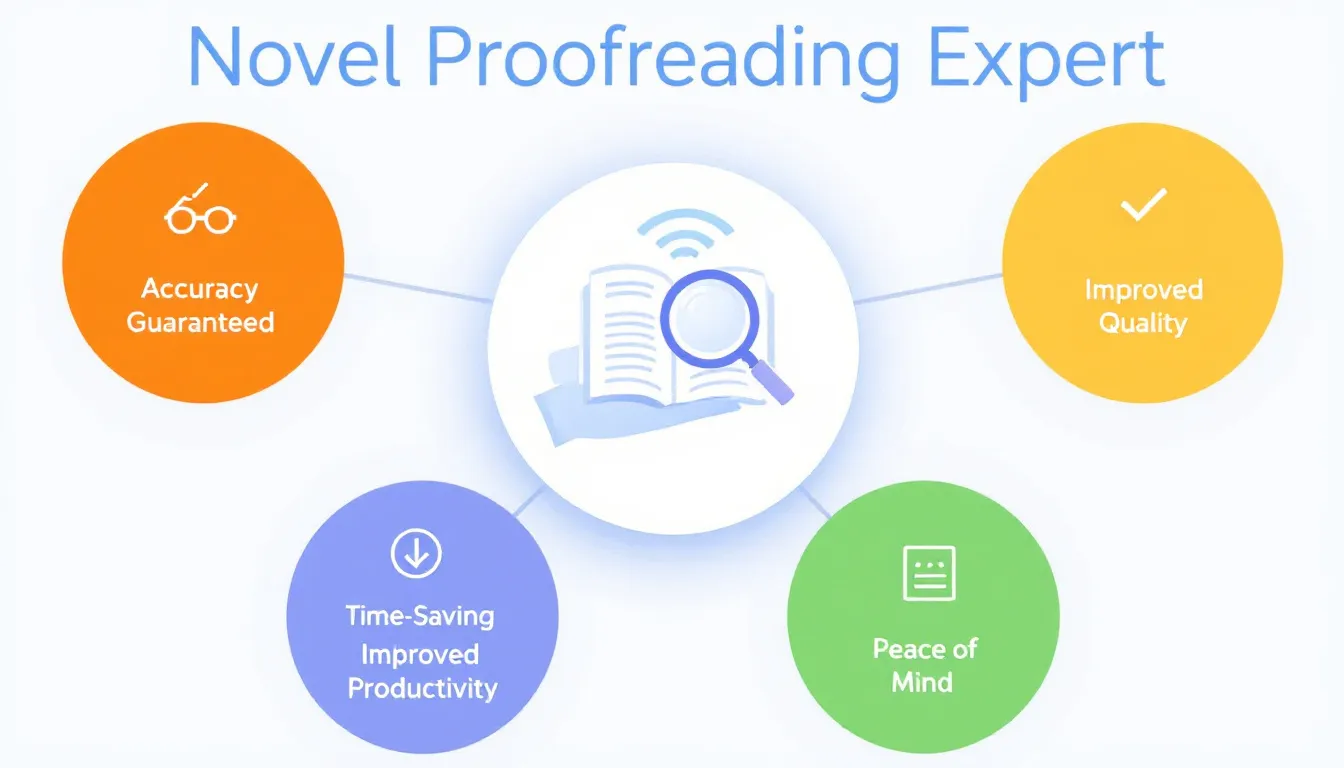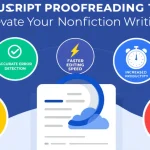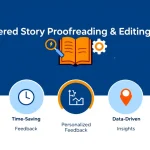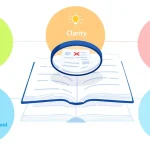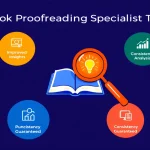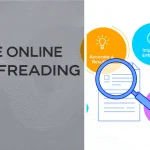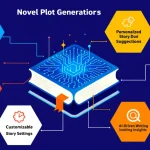Novel Proofreading Feedback
Is this tool helpful?
How to Use the Novel Proofreading Feedback Tool Effectively
To make the most of our Novel Proofreading Feedback Tool, follow these simple steps:
- Paste Your Novel Text: In the first text area labeled “The full text of the novel to be proofread,” copy and paste the entire text of your novel. This could be a complete manuscript or a specific chapter you want to focus on. For example, you might input the opening chapter of your mystery novel, starting with “The fog rolled in thick as Detective Sarah Blackwood stepped out of her car, the gravel crunching beneath her feet.”
- Specify the Genre or Style (Optional): In the “Genre or Style” field, enter the specific genre or style of your novel. This helps our tool provide more tailored feedback. For instance, you could enter “Gothic horror” or “Historical romance set in Regency England.”
- Define Your Target Audience (Optional): Use the “Intended Audience” field to describe your novel’s target readers. This information allows our tool to offer audience-specific suggestions. You might enter “Young adult readers interested in dystopian fiction” or “Middle-aged professionals who enjoy cozy mysteries.”
- Submit for Feedback: Once you’ve filled in the necessary information, click the “Get Proofreading Feedback” button. Our advanced AI will analyze your text and generate comprehensive feedback.
- Review the Results: The feedback will appear in the “Proofreading Feedback” section below the form. Take your time to carefully read through the suggestions and insights provided.
- Copy and Save: Use the “Copy to Clipboard” button to save the feedback for future reference or to share with your writing group or editor.
By following these steps, you’ll receive valuable insights to improve your novel’s grammar, style, and overall quality.
Revolutionize Your Writing with AI-Powered Proofreading
Welcome to the cutting-edge world of AI-assisted novel proofreading! Our Novel Proofreading Feedback Tool is designed to be your personal writing assistant, combining the power of advanced natural language processing with the nuanced understanding of literary craftsmanship. This innovative tool goes beyond simple spell-checking to provide comprehensive feedback on grammar, punctuation, syntax, narrative flow, and even stylistic elements specific to your chosen genre.
Whether you’re a seasoned author polishing your latest bestseller or a budding novelist working on your first manuscript, our tool offers invaluable insights to elevate your writing to new heights. By leveraging the latest advancements in machine learning and literary analysis, we’ve created a platform that not only catches technical errors but also offers suggestions to enhance your storytelling, character development, and overall reader engagement.
The Power of AI in Literature
Our Novel Proofreading Feedback Tool harnesses the capabilities of state-of-the-art language models to analyze your text with a level of depth and precision that was previously unattainable. By processing vast amounts of literary data, our AI has learned to recognize patterns, styles, and techniques employed by successful authors across various genres. This knowledge is then applied to your work, offering tailored suggestions that align with established best practices while preserving your unique voice.
Customized Feedback for Every Writer
One of the standout features of our tool is its ability to adapt to different genres and target audiences. By specifying your novel’s genre and intended readership, you activate specialized algorithms that fine-tune the feedback to match industry expectations and reader preferences. This customization ensures that the suggestions you receive are not just technically correct, but also stylistically appropriate and commercially viable.
Benefits of Using the Novel Proofreading Feedback Tool
1. Comprehensive Error Detection
Our tool meticulously scans your text for a wide range of potential issues, including:
- Grammatical errors (e.g., subject-verb agreement, pronoun usage)
- Punctuation mistakes (e.g., misplaced commas, incorrect use of semicolons)
- Spelling inconsistencies and typos
- Syntax problems that may affect readability
2. Enhanced Narrative Flow
Beyond technical corrections, the tool analyzes the overall structure and pacing of your narrative, offering suggestions to improve:
- Paragraph transitions
- Scene pacing and rhythm
- Dialogue flow and authenticity
- Consistency in point of view and tense
3. Style and Tone Refinement
Our AI provides insights on stylistic elements, helping you refine:
- Voice consistency throughout the novel
- Use of literary devices (e.g., metaphors, similes, foreshadowing)
- Sentence variety and structure for improved readability
- Word choice and vocabulary appropriate for your genre and audience
4. Time and Cost Efficiency
By using our tool, you can:
- Reduce the time spent on manual proofreading
- Minimize the need for multiple rounds of human editing
- Identify and address major issues before submitting to agents or publishers
- Save on professional editing costs by pre-polishing your manuscript
5. Continuous Learning and Improvement
As you use the tool, you’ll gain insights into common mistakes and areas for improvement in your writing. This knowledge can help you:
- Develop better writing habits
- Identify personal patterns and weaknesses in your style
- Refine your craft with each subsequent project
Addressing User Needs and Solving Specific Problems
Tackling Common Writing Challenges
Our Novel Proofreading Feedback Tool is designed to address a multitude of writing challenges that authors frequently face:
1. Overcoming Writer’s Block
By providing detailed feedback on your existing text, our tool can help spark new ideas and directions for your story. For example, if you’ve written a scene where your protagonist is struggling with a decision, the tool might suggest ways to deepen the internal conflict or introduce external factors that could influence the character’s choice.
2. Maintaining Consistency in Long Manuscripts
For novelists working on lengthy works, keeping track of details, character traits, and plot points can be challenging. Our tool helps by flagging potential inconsistencies. For instance, if a character’s eye color changes from blue to brown midway through the novel, or if a subplot is introduced but not fully resolved, the tool will highlight these issues for your attention.
3. Adapting to Genre Conventions
Different genres have specific expectations and tropes that readers anticipate. Our tool, when provided with your novel’s genre, can offer suggestions to align your work with these conventions while still maintaining originality. For a romance novel, it might recommend balancing character development with relationship progression. In a thriller, it could suggest pacing adjustments to build tension effectively.
4. Enhancing Dialogue Authenticity
Crafting believable dialogue is crucial for character development and reader engagement. Our tool analyzes conversations in your novel and provides feedback on:
- Dialogue tags and attributions
- Balance between dialogue and narrative
- Character-specific speech patterns and vocabulary
- Subtext and implied meanings
5. Improving Show vs. Tell Balance
One common challenge for writers is finding the right balance between showing and telling in their narratives. Our tool can identify passages where you might be relying too heavily on exposition and suggest ways to convey the same information through action, dialogue, or sensory details.
Practical Application Example
Let’s consider a practical example of how our Novel Proofreading Feedback Tool can transform a piece of writing:
Original Passage:
“John was angry. He walked into the room and saw Mary sitting there. She looked sad. ‘What’s wrong?’ he asked. Mary sighed. ‘Nothing,’ she said. John didn’t believe her.”
Tool Feedback and Suggestions:
- Consider showing John’s anger through actions or physical descriptions rather than stating it directly.
- Enhance the scene by incorporating sensory details to create a more vivid atmosphere.
- Develop the dialogue to reveal character emotions and relationships more effectively.
- Use stronger verbs to convey emotions and actions more vividly.
Revised Passage Based on Feedback:
“John’s fists clenched as he stormed into the dimly lit room. The floorboards creaked under his heavy steps. Mary sat hunched in the corner, her eyes red-rimmed and downcast. ‘What’s eating you?’ John growled, his voice barely masking his own turmoil. Mary’s shoulders sagged as she exhaled. ‘It’s nothing,’ she murmured, her gaze fixed on the worn carpet. John’s eyebrow arched, skepticism etched across his face.”
This revised version demonstrates how the tool’s suggestions can lead to more engaging and emotionally resonant prose, bringing the scene to life for the reader.
Practical Applications and Use Cases
1. Manuscript Polishing for Submission
Authors preparing to submit their manuscripts to literary agents or publishers can use our tool to ensure their work is as polished as possible. By addressing grammar issues, improving narrative flow, and enhancing overall readability, writers increase their chances of making a strong first impression.
Example:
An aspiring author, Sarah, used our tool to refine her 80,000-word science fiction novel before submitting it to her dream agent. The feedback helped her tighten her prose, eliminate redundancies, and strengthen her world-building descriptions. As a result, she received a request for a full manuscript within two weeks of querying.
2. Self-Publishing Preparation
For authors choosing the self-publishing route, our tool serves as a cost-effective first round of editing. It helps identify and correct issues that might otherwise require multiple passes by human editors, potentially saving hundreds or even thousands of dollars in editing fees.
Example:
Mark, a self-published mystery author, ran his latest novel through our tool before sending it to his editor. The feedback helped him catch numerous small errors and inconsistencies in his plot timeline. His editor was impressed by the cleaner manuscript, which allowed them to focus on deeper story elements rather than surface-level corrections.
3. Writing Workshops and Critique Groups
Writers participating in workshops or critique groups can use our tool to pre-polish their submissions. This ensures that the feedback they receive from peers focuses on substantive issues rather than basic grammar and style concerns.
Example:
A local writing group in Portland implemented a policy of running all workshop submissions through our tool before sharing. This practice elevated the quality of discussions, allowing members to delve into advanced topics like character motivation, theme development, and narrative structure.
4. Academic Writing and Dissertations
While primarily designed for creative writing, our tool can also assist academic writers working on lengthy projects like dissertations or theses. It helps maintain consistency in tone and style throughout the document and ensures clarity in complex arguments.
Example:
Dr. Emily Chen used our tool while writing her 200-page dissertation on 20th-century American literature. The feedback helped her maintain a consistent academic tone while also suggesting ways to make her arguments more engaging and accessible to a broader audience.
5. Content Marketing and Blogging
Content creators looking to produce high-quality, engaging blog posts or marketing materials can benefit from our tool’s ability to analyze narrative structure and improve readability.
Example:
A digital marketing agency incorporated our tool into their content creation workflow. They found that articles refined with the tool’s suggestions saw a 25% increase in average time on page and a 15% boost in social media shares.
6. ESL Authors and International Markets
Authors writing in English as a second language can use our tool to catch nuanced language errors and improve idiomatic expressions. This is particularly valuable for writers aiming to break into English-language markets.
Example:
Yuki, a Japanese author, used our tool to refine the English translation of her bestselling novel. The feedback helped her translator capture the essence of her writing style while ensuring the text read naturally to an English-speaking audience. The novel went on to become a critical success in the US market.
Frequently Asked Questions (FAQ)
Q1: How long does it take to receive feedback from the Novel Proofreading Feedback Tool?
A1: The processing time depends on the length of your text, but most users receive feedback within minutes. For very long manuscripts (over 100,000 words), it may take up to an hour.
Q2: Can I use this tool for languages other than English?
A2: Currently, our tool is optimized for English language texts. We’re working on expanding to other languages in the future.
Q3: How does specifying the genre help improve the feedback?
A3: By indicating your novel’s genre, you activate specialized algorithms that understand genre-specific conventions, tropes, and reader expectations. This allows for more tailored suggestions that align with industry standards for your chosen genre.
Q4: Is this tool suitable for screenplays or stage plays?
A4: While primarily designed for prose fiction, many users find our tool helpful for script writing as well. However, for best results with screenplays or stage plays, we recommend using software specifically designed for those formats.
Q5: Can this tool help with character development?
A5: Yes! Our tool analyzes character consistency, dialogue patterns, and character arcs. It can provide suggestions for deepening characterization and ensuring distinct voices for different characters.
Q6: How often should I use this tool during my writing process?
A6: We recommend using the tool at various stages: after completing your first draft, during revisions, and as a final check before submitting to agents or publishers. However, it’s important not to rely solely on the tool and to trust your creative instincts as well.
Q7: Can this tool replace human editors?
A7: While our tool is powerful, it’s designed to complement rather than replace human editors. It’s an excellent first step in the editing process, catching many issues and improving overall quality, but we still recommend working with professional editors for final polishing, especially for works intended for publication.
Q8: Is my novel’s content kept confidential when I use this tool?
A8: Absolutely. We take user privacy very seriously. All content submitted to our tool is processed securely and is not stored or used for any purpose other than providing feedback to the user.
Q9: Can I use this tool for non-fiction writing?
A9: Yes, while our tool is optimized for fiction, many users find it helpful for non-fiction projects as well. It can assist with clarity, structure, and maintaining a consistent tone throughout your work.
Q10: How does the tool handle experimental or unconventional writing styles?
A10: Our tool is designed to recognize a wide range of writing styles. For highly experimental works, you can indicate this in the genre field, and the tool will adjust its analysis accordingly, focusing more on internal consistency rather than conventional rules.
By leveraging the power of our Novel Proofreading Feedback Tool, you’re not just correcting errors; you’re elevating your craft, refining your storytelling, and preparing your work to captivate readers. Whether you’re crafting your first novel or your fifteenth, this tool is an invaluable companion on your writing journey, helping you transform your raw ideas into polished, professional-quality prose.
Important Disclaimer
The calculations, results, and content provided by our tools are not guaranteed to be accurate, complete, or reliable. Users are responsible for verifying and interpreting the results. Our content and tools may contain errors, biases, or inconsistencies. We reserve the right to save inputs and outputs from our tools for the purposes of error debugging, bias identification, and performance improvement. External companies providing AI models used in our tools may also save and process data in accordance with their own policies. By using our tools, you consent to this data collection and processing. We reserve the right to limit the usage of our tools based on current usability factors. By using our tools, you acknowledge that you have read, understood, and agreed to this disclaimer. You accept the inherent risks and limitations associated with the use of our tools and services.
